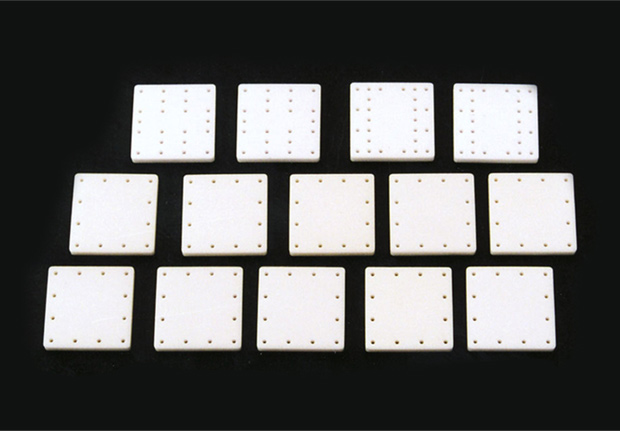Technology
Substrates for IBM's System/360 Computer
In 1966, Kyocera received an order from IBM to build 25 million alumina substrates for hybrid integrated circuits (ICs), an order won through a competitive bidding process involving advanced ceramics manufacturers worldwide.
*Hybrid ICs: Integrated circuits comprised of resistors, capacitors, transistors, diodes, semiconductor IC chips, other components and circuitry mounted on substrates of ceramic or glass.
Kyocera's alumina substrates were destined for use at the heart of a revolutionary new computer system. IBM was inaugurating the "third-generation" of mainframe computing with the first modular, expandable general-purpose computers capable of supporting both scientific and business applications. For its ICs, IBM adopted a new innovation known as Solid Logic Technology (SLT) to package its unique microelectronic circuits, and the alumina substrates for these ICs came from Kyocera.
Given that IBM was embedding state-of-the-art technology onto these circuits, the specifications for the substrates were strictly defined in minute detail. For example, Kyocera had been producing 15x15mm square substrates with dimensional tolerance of ±1.5/100 millimeters; IBM demanded a 3X tighter tolerance of just ±0.5/100 millimeters. Specifications like this were compiled into a thick book.
In response to these rigorous demands, Inamori personally oversaw every aspect of the work, from formulating raw materials to inspecting finished substrates. He visited the factory floor daily, identified and promptly rectified issues at each stage of the process, and provided direct guidance to employees.
He purchased new production and inspection equipment without hesitation, and worked late into the night alongside his employees. He thanked them frequently for their diligence, urging them to "keep up the good work tomorrow," and even stayed behind alone at the worksite to continue development after everyone else had gone home.
Seven months after Inamori's development effort began, Kyocera's substrates passed IBM's inspection and were incorporated into the heart of the world's first large-scale general-purpose computer, the System/360. News that Kyocera's ceramic parts had been installed in IBM's landmark new computer helped enhance both Kyocera's reputation and the credibility of ceramics worldwide. Five decades later, a System/360 model was added to the Smithsonian Institution's National Museum of American History in Washington, DC, in recognition of the computer's historic role in opening a new era of information technology worldwide.

15mm square alumina substrates drilled with tiny via holes for interlayer wiring connections